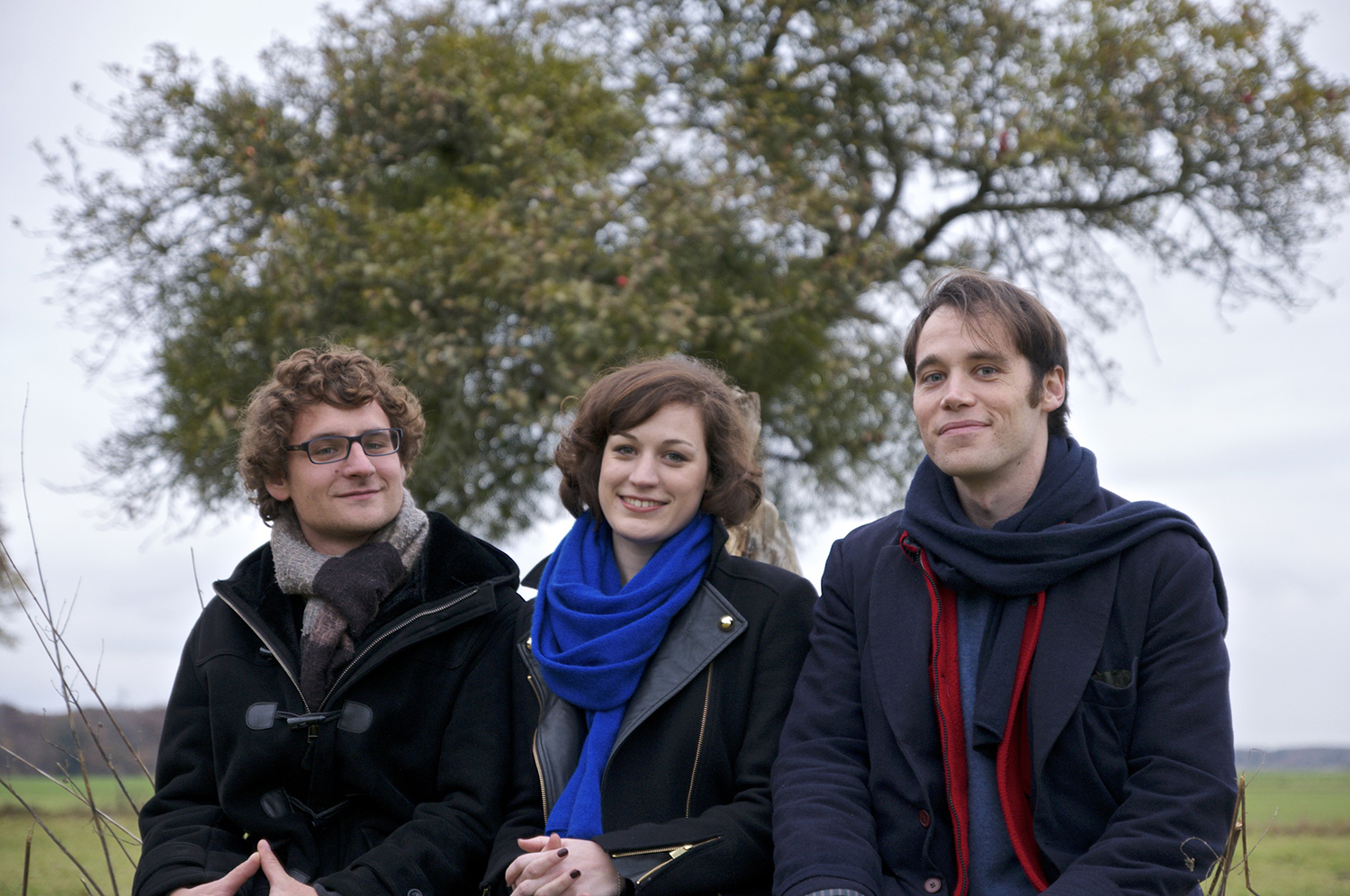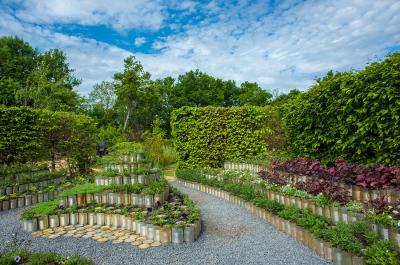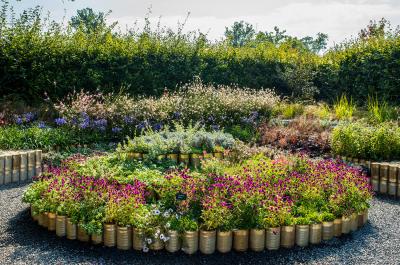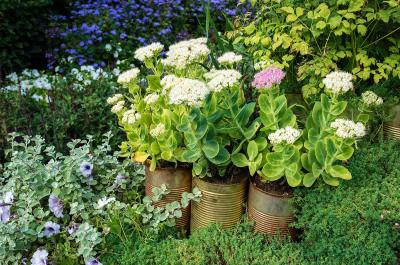07. LE JARDIN MIS EN BOÎTE
The designers of the garden condemns our society of over-consumption, greed, gluttony, wasting food, whilst other societies endure misery and penury.

Before entering the garden, look upon it for a moment from afar, like the ruins of a temple that once was dedicated to the consumer society. Here, each can of food, formerly a marketing item, has been transformed into a flowerpot to receive Nature, which is re-asserting its rights.
Take the time to sit and look at the various plants, grouped by colour and by variety. The plants take up the whole space, as in the aisles of supermarkets abandoned in the middle of infinite, infertile parking areas.
Sitting in the middle of cans of food, symbols of consumption, you meditate on what a world could be that would be more just in sharing out wealth.
designers

DE architect Victor Lepage and palynologist Kevin Lemmonier have been friends since childhood. They share and encourage, together and with others, views and walks in the territory of Haute Normandie. Alexandra Lehec, DE architect, met Victor at the Ecole d’Architecture de Normandie and they travelled together, as well as carrying out various reflections and architectural projects, both professionally and as students. Although the group already brought poetic and aesthetic visions to the region, and even scientific knowledge, she - coming from a family of livestock farmers in Basse Normandie, was able to contribute her practical know-how. After talking infinitely about plans that never came to fruition, they embarked on their first collective work for the Chaumont-sur-Loire International Garden Festival.
Following a scientific baccalaureate, Kevin Lemonnier continued his studies in the field of chemistry. Driven by his curiosity and a desire to understand the principles which govern natural environments, he enrolled at the Université de Rouen and graduated in earth and life science, with a focus on ecology and the biology of organisms in 2011. Influenced by nature in Normandy and treks across its different ecosystems, he inevitably then went on to study the environment and plants. Following work experience and a temporary contract as a flora research fellow in an environmental design company, he worked for 8 months at the Jardin des Saules garden Centre in Saint Just. It is thanks to this experience that he joined the CNRS in December 2012 as a palynologist technician. In the oceanography and climate laboratory LOCEAN, he studied variations in vegetation over time, based on observations of pollen fossilised during sedimentation.
A native of Giverny in Eure, since childhood Victor Lepage has roamed the Haut Normandie region for as long as his feet will carry him. Passionate about drawing and design, he chose to study architecture, enrolling at the ENSA Normandie. His training directed his perspective of his birth place towards an awareness of the "walking landscape" and of the "environment as a resource of play". During his studies, he had the opportunity to be exhibited and published for the first time at the Paris Pavillon de l’Arsenalfor the project "Corps à corps" designed alongside Mathieu Maury who was then an architecture student. He continued his training in a working environment in the Netherlands, where he met Harmen Van De Wal, founder of Krill Architecture, and thanks to whom he contributed to envisaging possible identities of the Lingezegen natural park, at an international workshop. After a brief return to France, his research seminar drove him to go back to Holland for a while. Guided at the time by Henry Borduin at the firm Border Architecture, he set to work on the issue of "perceived space" through the study of natural light as a material and the design of architectural devices of indirect light. He graduated in July 2012 with the project "Citadine, une gare pour espace public" designed alongside Alexandra Lehec, thus putting into practice and synthesising a shared path. He developed his interest for so-called fun plants that he displayed during the competition "changer d’ère, changer d’air" in Paris in September 2003, to bring city-dwellers' awareness back to the environment and to define urban space as a space of freedom and play. Nowadays, when he feels like coming down from the clouds, he works as a freelance architect for individuals and private companies.
Alexandra Lehec studied at the École Supérieure d’Architecture de Normandie and was awarded her State Architect Diploma with the project "Citadine, une gare pour espace public". Rural practices and the related knowledge and actions, transmitted through her family environment, have heavily influenced her concept of landscape and her interpretation of territories. In both architecture and town planning, for her there is the intention to relate the landscape to the practical, the desire to bring it to life and put it in motion, principally by creating spaces of freedom. During her studies she was selected for the exhibition at the Paris Pavillon de l’Arsenal of the project "Construire le vide" alongside Julien Greverend, then for her publication in the book "Seine d’architecture", in which she considers the relationship between André Citroen park in Paris and the Seine as being a public space. She got close to the field of architectural research during work experience in Amsterdam in the Netherlands, where worked on innovation and experimentation of lighting systems for a building in Austria designed for working comfort and relaxation. She likes to work on concepts, but also to be able to approach things in a concrete way, just as she likes to relate knowledge to action.


